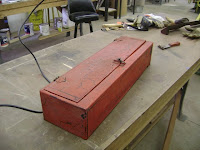I started out working on stripping paint off the flag box and flag tray from one end of the 319. All CA&E woods have a box and a tray mounted near the ceiling in each vestibule for storage of flags and other small items. Below left, the flag box seen before stripping; below right, it is partly stripped. The flag box may have been an original "factory-equipped" item, I'm not sure, but either way both it and the flag tray definitely date back to the AE&C Pullman green era.


Then, with help from a pop rivet gun Rod procured from the Coach Department, I installed the last two metal patches on the 205 corner posts. Pop rivets are definitely not used in any full restorations at IRM but, for a cosmetic restoration like this, it saved an awful lot of time and effort and will not notably effect the appearance of the car. Below left, the hole rusted in the car's corner post before patching; below right, the patch after installation. When the weather warms up this area will be touched up with body filler and primed.


Following this I did a bit of work to reassemble the second MU socket that Rod had modified a couple of years ago so that it will be ready to install on the east end of the car and then laid out plans for the wooden "donut" which is bolted in place between the socket and the car's dash panel.
 Finally, here's an interesting bit of Illinois Terminal minutiae. When the IT converted the 277 to air conditioning they also installed truck-mounted brake cylinders. As part of this project, they apparently designed and built in their own shops an air valve assembly designed to isolate and cut out a single truck in the event of an air hose failure. That assembly, pictured above, was partly clogged with gunk which may have contributed to some of this car's brake problems while at IRM. It's kind of a Rube Goldberg device and may have never been serviced since the car left the IT, but Rod disassembled and cleaned it with help from Joe, Greg and Joel.
Finally, here's an interesting bit of Illinois Terminal minutiae. When the IT converted the 277 to air conditioning they also installed truck-mounted brake cylinders. As part of this project, they apparently designed and built in their own shops an air valve assembly designed to isolate and cut out a single truck in the event of an air hose failure. That assembly, pictured above, was partly clogged with gunk which may have contributed to some of this car's brake problems while at IRM. It's kind of a Rube Goldberg device and may have never been serviced since the car left the IT, but Rod disassembled and cleaned it with help from Joe, Greg and Joel.
{ 0 comments... Views All / Send Comment! }
Post a Comment